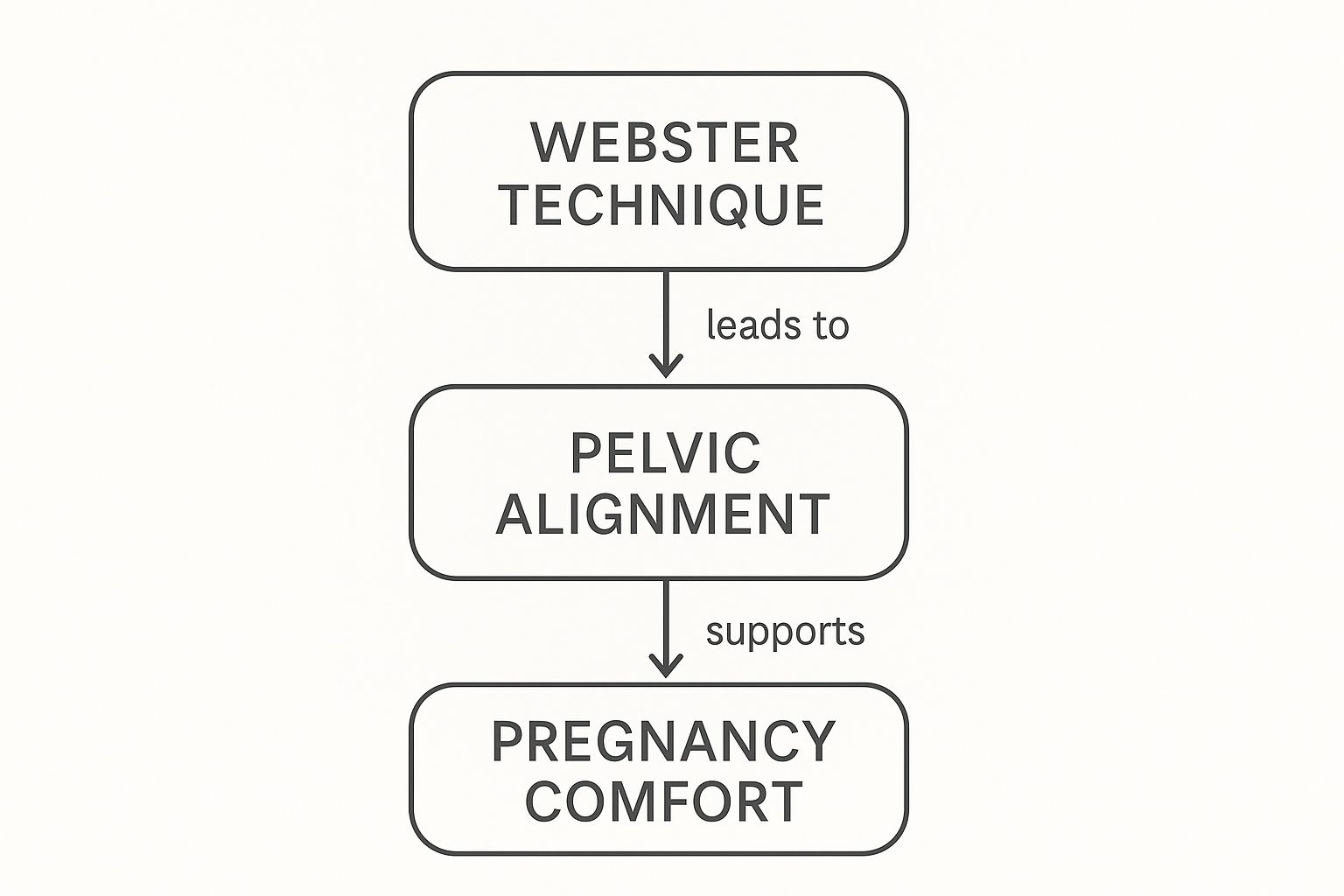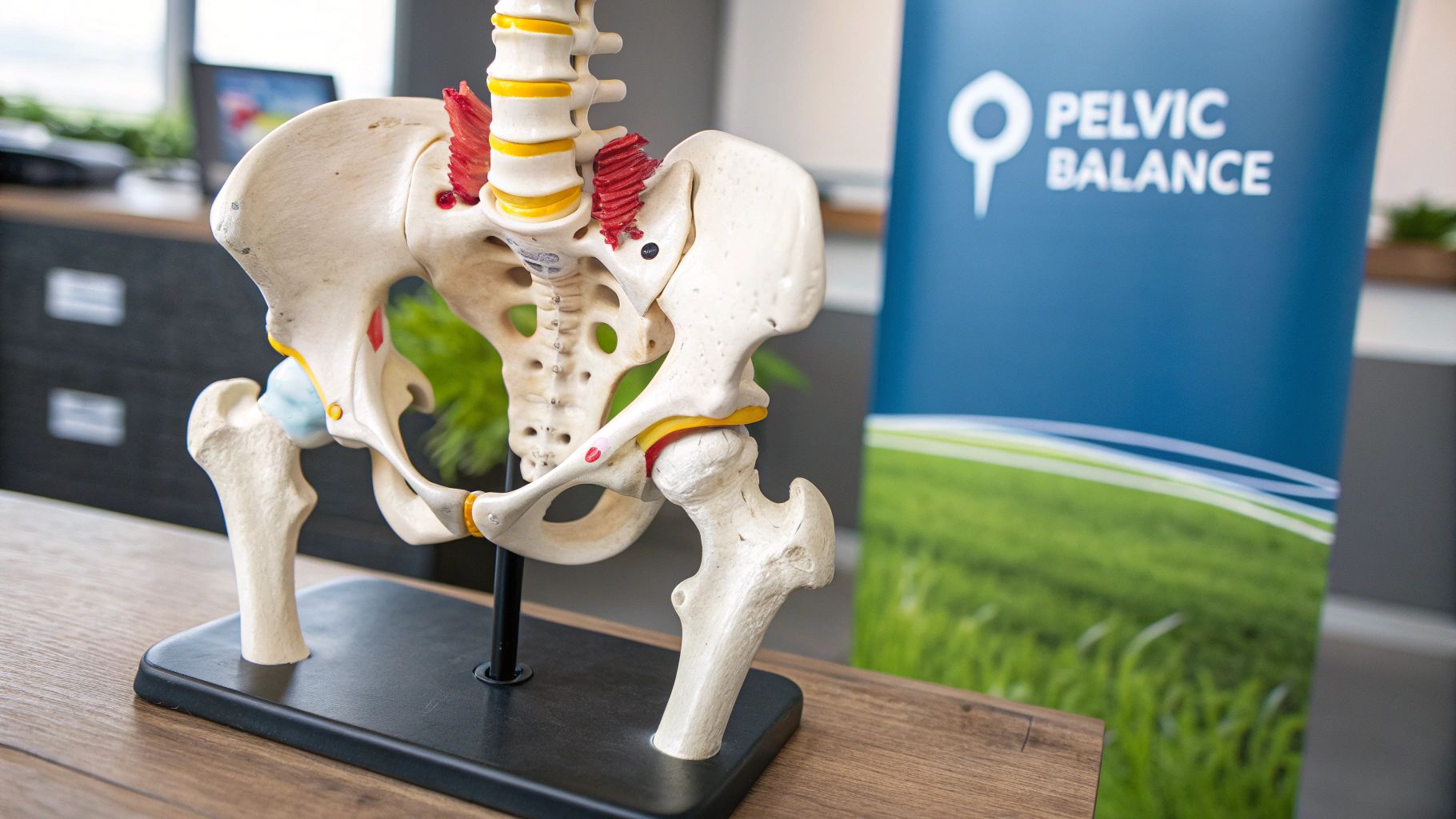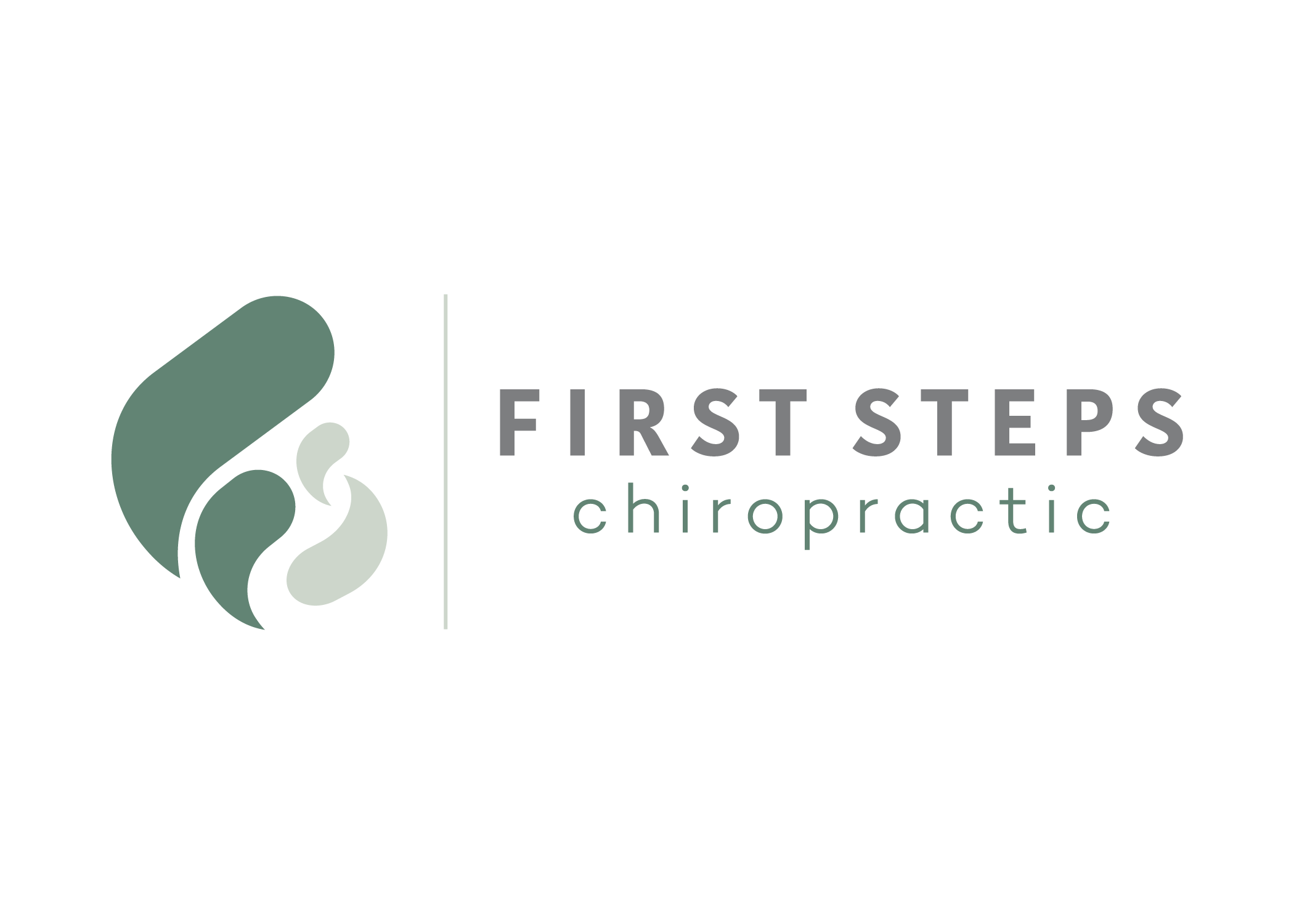The Webster Technique is a very specific chiropractic analysis and adjustment used to help pregnant women. The simplest way to think about it is this: your pelvis is the "cradle" for your growing baby. This gentle, safe method helps ensure that cradle is perfectly aligned, creating the best possible environment for your baby to thrive—without ever trying to physically turn them.
A Gentle Approach to Pregnancy Comfort
Pregnancy brings a whirlwind of incredible physical changes, and staying comfortable is key to a positive experience. As your body makes room for new life, your pelvis naturally shifts and adapts. Sometimes, though, these changes can lead to misalignments that cause discomfort or even tighten the space your baby has to move around.
This is exactly where the Webster Technique shines. It’s important to understand that it’s not a method for "turning" a breech baby. Instead, it’s a gentle way to restore proper neuro-biomechanical function to the pelvis. By correcting these subtle imbalances, the technique releases tension in the surrounding muscles and ligaments, giving your baby more room to move freely and get into the best possible position for birth.
For a quick overview of what the Webster Technique entails, check out this table.
The Webster Technique At a Glance
| Aspect | Description |
|---|---|
| Primary Goal | To restore proper neuro-biomechanical function in the pelvis of a pregnant woman. |
| Focus | Sacral and pelvic analysis and adjustment. |
| Is it a baby-turning technique? | No. It balances the pelvis to allow the baby to move into an optimal position on its own. |
| Key Principle | Reducing intrauterine constraint by addressing sacral subluxation and round ligament tightness. |
| Who is it for? | All pregnant women, as it helps create an ideal environment for the baby throughout pregnancy. |
This summary highlights how the technique focuses on the mother's pelvic health to indirectly benefit the baby.
The Foundation of Pelvic Balance
The core idea behind the Webster Technique is all about addressing misalignments in the pelvis and sacrum. Your sacrum is that triangular bone at the very base of your spine, and it’s a critical part of your pelvic girdle. When it gets misaligned (something we chiropractors call a subluxation), it creates a domino effect.
This imbalance can cause the round ligaments—the "support ropes" holding your uterus in place—to become tight and twisted.
When one of these ligaments is under tension, it can pull on the uterus, creating what’s known as intrauterine constraint. This simply means the baby has less space to move into the ideal head-down position for birth.
This diagram helps visualize how pelvic alignment is directly connected to a more comfortable pregnancy.

As you can see, by focusing on the health of the pelvis, the Webster Technique supports a more functional and comfortable pregnancy from start to finish.
A Legacy of Supporting Mothers
The technique was born from a desire to make birth experiences better. It was developed back in the 1980s by Dr. Larry Webster, a chiropractor who was inspired to find a better way to support pregnant women after his own daughter had a difficult labor. His work centered on the crucial role pelvic balance plays in reducing the complications that can arise from intrauterine constraint.
This focus on helping the body function as it's designed to is why so many expecting mothers seek it out. While the benefits often go far beyond just fetal positioning, creating that unrestricted environment for the baby is a key outcome. To see how this fits into a complete wellness plan, you can explore our guide on chiropractic care during pregnancy. By ensuring the pelvis is balanced, the Webster Technique helps set the stage for a smoother, more comfortable journey to motherhood.
Understanding How Pelvic Balance Works
To really get what the Webster Technique does, we first have to appreciate the incredible way your body is engineered for pregnancy. Your pelvis isn't just a fixed, rigid bone structure; it's a dynamic cradle designed to shift, adapt, and make room for your growing baby. Understanding this relationship between pelvic balance and your uterus is the key to seeing why this specific chiropractic approach can be so helpful.

Think of your pelvis as the foundation of a house. If that foundation is level and stable, everything built on top of it works just right. During pregnancy, this "foundation" has to handle huge changes, and even a minor misalignment can create a significant ripple effect.
The Sacrum and Its Central Role
The cornerstone of this pelvic foundation is the sacrum—that triangular bone at the base of your spine, nestled right between your two hip bones. This bone is a huge player in your body’s stability and how your nervous system functions. When your sacrum is aligned properly, your pelvis can move and expand exactly as it needs to.
But the increasing weight of a growing baby, plus the hormonal changes that relax your ligaments, can sometimes cause the sacrum to shift out of place. This is what chiropractors call a sacral subluxation, and it can throw the balance of the entire pelvic girdle off kilter.
This is precisely where the Webster Technique comes in. It’s designed to improve the biomechanics of the pelvis by addressing that sacral subluxation. By restoring balance, it helps optimize the function of the nervous system in the pelvic area. A chiropractor will use precise, gentle adjustments combined with soft tissue work—like massaging the round ligaments that connect the uterus to the pelvis. For a more technical breakdown, you can explore the Webster Technique and its principles on Wikipedia.
When the sacrum is misaligned, it creates an uneven pull on the surrounding muscles and ligaments, which brings us to the next crucial piece of the puzzle.
The Round Ligaments: A Simple Analogy
Your uterus is connected to your pelvis by two important structures called the round ligaments. A great way to picture how they work is to think of your uterus as a hot air balloon. The round ligaments are like the ropes anchoring that balloon to the ground, keeping it stable and supported.
When your pelvis is balanced, those "ropes" have equal, gentle tension on them. This allows the balloon—your uterus—to expand symmetrically.
Now, what happens if one of those ropes gets twisted or pulled too tight? That’s exactly what can happen when the sacrum is out of alignment. The pelvic imbalance creates uneven tension on one of the round ligaments.
This torsion doesn't just stay in the ligament; it pulls on the uterus itself, subtly changing its shape and reducing the amount of space available inside. This is the core concept of intrauterine constraint.
This isn't about your body being the "wrong shape." It's simply about restoring proper function so your baby has the most room possible to move around.
From Imbalance to Intrauterine Constraint
Intrauterine constraint is the direct result of that pelvic imbalance. When the sacrum is misaligned and the round ligaments are under uneven tension, the baby's living space can become restricted. This can make it much harder for them to get into the optimal head-down position for birth.
Here’s how that domino effect plays out:
- Pelvic Misalignment: It all starts with a subtle shift in the sacrum or SI joints.
- Ligament Tension: This shift creates an uneven pull on the round ligaments that support the uterus.
- Uterine Torsion: The uneven pull causes a slight twisting or tightening of the uterine wall.
- Reduced Space: This results in intrauterine constraint, which limits the baby's ability to move freely.
The Webster Technique goes right to the root of this chain reaction. By gently correcting the pelvic misalignment and releasing the tension in the ligaments, it restores balance to the whole system. The goal isn't to force the baby to move. It's about creating a more spacious, symmetrical environment that allows the baby to find the best position all on their own. It’s all about facilitating the body's natural wisdom.
What to Expect During Your Appointment
Stepping into a chiropractor's office for a Webster Technique session while pregnant might feel a little new or uncertain, but rest assured, the entire experience is designed to be gentle, calm, and supportive. Knowing what happens during an appointment can help take the mystery out of it and put your mind at ease.
From the moment you walk in, the focus is squarely on your comfort and well-being.
Your first visit always starts with a good conversation. Your certified practitioner will want to hear your story—your health history, details about your pregnancy, any aches or pains you're feeling, and what you hope to achieve with care. This initial chat is key to crafting a plan that's just right for you.

A Gentle and Comfortable Assessment
After you've talked, your chiropractor will do a gentle physical assessment. This isn't your typical medical exam; it's a very specific analysis of your pelvic alignment and the tension in the ligaments around it. You'll be positioned comfortably on a specialized table made for pregnant bodies, complete with pillows and drop-away sections to give your growing belly plenty of room.
This analysis is the first of two main parts of the Webster Technique. It’s incredibly precise but very gentle. The chiropractor will assess the alignment of your sacrum—that triangular bone at the very base of your spine. This is usually done while you’re lying face down, completely supported by pillows, so there's zero pressure on your abdomen.
The practitioner is looking for subtle signs of a sacral misalignment or SI joint dysfunction, which can create imbalance in the pelvic girdle. This whole part of the process is non-invasive and should feel completely comfortable.
The Two-Part Adjustment Process
Once the analysis is done, the adjustment begins. The Webster Technique is a two-step process that addresses both the bony structure of your pelvis and the soft tissues connected to it. Both pieces are equally important for restoring balance.
Here’s how it usually unfolds:
-
Sacral Adjustment: Based on the assessment, the chiropractor performs a very gentle and specific adjustment to your sacrum. This isn't a forceful "crack" or "pop" you might imagine. It often involves just a light, sustained pressure or a specialized instrument to gently guide the bone back into a better position. Many women say they feel an immediate sense of release or lightness.
-
Round Ligament Release: The second step is all about the soft tissues, specifically the round ligament. Your practitioner will apply gentle, sustained pressure to a specific spot on your abdomen. The goal is to release tension in the ligament that might be creating a pull on the uterus. This is completely safe and is always done with the utmost care for both you and your baby.
The entire adjustment is remarkably gentle. The goal is never to force anything but to work with your body's innate ability to find balance, creating a more optimal environment for your baby to move and get into the best possible position for birth.
What Does It Feel Like?
For most women, the experience is actually quite relaxing. The adjustments are light, and the ligament work feels like a gentle, steady pressure. There shouldn't be any pain. Your chiropractor will be talking with you the entire time, making sure you’re comfortable and at ease.
How often you come in will depend on your specific needs. Your practitioner may suggest a series of appointments to help your body hold its new alignment as your pregnancy progresses. Each session builds on the last, supporting your pelvic balance as you move through your second and third trimesters, paving the way for a more comfortable pregnancy and birth experience.
How One Doctor’s Vision Became a Global Standard
Like so many game-changing ideas, the Webster Technique wasn’t dreamed up in a research lab—it was born from a deeply personal experience. The story starts with its founder, Dr. Larry Webster, a chiropractor who was passionate about helping kids and expecting mothers.
His mission to create this specific method began after he watched his own daughter go through a difficult and traumatic birth. That experience lit a fire in him. Dr. Webster was determined to find a chiropractic approach that could help ease the challenges of labor by making sure a mother’s body was working exactly as it should be. He believed that misalignments in the pelvis were a major roadblock in difficult births, which led him to develop a specific analysis and adjustment focused entirely on restoring balance to the pelvis.
From Personal Mission to Professional Standard
What started as one doctor’s vision soon got noticed for being both gentle and incredibly effective. As more and more chiropractors saw the positive changes in their pregnant patients, it became clear they needed a standardized way to teach and certify this unique approach.
That’s where the International Chiropractic Pediatric Association (ICPA) came in. The ICPA is now the global leader for this specialized care, and it’s the main organization that trains and certifies doctors in the Webster Technique. This ensures that no matter where you are in the world, the care you receive is consistent and held to a high standard.
To make it official, the ICPA created the Webster Technique Proficiency Certification program. It’s a comprehensive 12-hour course that gives chiropractors the exact skills they need for pelvic analysis and adjustment, all with the goal of improving neuro-biomechanical function. You can dive deeper into the ICPA's mission on their official website.
The site really underscores their focus on family wellness, offering resources for both parents and professionals who are dedicated to chiropractic care for kids and during pregnancy.
Evolving the Language of Care
One of the most important parts of the technique’s journey has been a shift in how we talk about it. For a while, it got a reputation as a “breech-turning” technique. And while it’s true that creating more room can help a baby move into the best head-down position, that label was never quite right.
The ICPA has been crucial in clearing up this misunderstanding.
The Webster Technique is not a treatment for breech presentation, nor is it an attempt to physically turn a baby. Its sole purpose is to detect and correct sacral subluxation, restoring proper pelvic alignment and function for the mother.
This is a critical distinction. It moves the focus away from a specific outcome (like the baby’s position) and puts it squarely on the root cause—an imbalance in the mother’s pelvis. By correcting the mom’s neuro-biomechanics, the technique simply gives the baby the space to move on its own.
This refined understanding helps set the right expectations and truly highlights the technique's role in supporting the body's own natural intelligence. This journey—from one man’s personal discovery to a globally recognized certification—is exactly why the Webster Technique has become such a trusted part of modern prenatal wellness.
Potential Benefits for You and Your Baby
Most people hear about the Webster Technique when they’re worried about a breech baby, but its benefits go so much deeper than just fetal positioning. Think of it this way: the core goal is to restore balance to your pelvis. When we achieve that, it creates a positive ripple effect that helps both you and your baby throughout the entire pregnancy and even during delivery.
This isn’t about forcing anything. It's about gently addressing the root cause of many common pregnancy complaints—pelvic misalignment—so your body can function the way it’s designed to. We're aiming to create a more comfortable home for you and a more spacious one for your baby.

Promoting Comfort and Ease for You
Pregnancy puts your body through incredible changes. Your center of gravity shifts, hormones are loosening ligaments, and your pelvis and spine are under a whole new kind of stress. Keeping the pelvis balanced can make a world of difference in how you experience these nine months.
Many women who come in for the Webster Technique tell us they feel significant relief from those all-too-common pregnancy aches and pains. Here’s what you might experience:
- Reduced Back and Pelvic Pain: By correcting sacral subluxation and SI joint dysfunction, the technique gets right to the source of low back pain, hip discomfort, and that nagging pelvic girdle pain.
- Relief from Sciatica: That sharp, shooting pain down your leg? It often comes from a misaligned pelvis putting pressure on the sciatic nerve. Restoring balance can take that pressure off and bring lasting relief.
- Improved Mobility: When the pain and stiffness ease up, simple things like walking, sleeping, and just getting through your day become so much easier and more comfortable.
The Webster Technique helps transform the pregnancy experience from one of endurance to one of enjoyment. By supporting your body’s structural integrity, it helps you feel stronger and more balanced as you approach childbirth.
And the benefits aren't just physical. When you feel more comfortable in your own body, it can lower stress and boost your overall sense of well-being, which is priceless during this time.
Creating an Optimal Environment for Your Baby
While we perform the Webster Technique on you, the most profound benefits are often for your baby. A balanced pelvis means a more balanced uterus, giving your little one the ideal space to grow and move.
The main way this helps your baby is by reducing what’s called intrauterine constraint. When pelvic misalignments tighten the uterine ligaments, it can restrict the baby's space. This can make it tough for them to get into the best head-down (vertex) position for birth.
By restoring that pelvic balance, the Webster Technique can:
- Allow for Optimal Fetal Positioning: With more room to wiggle around, a baby has a much better chance of turning head-down all on their own. Studies have shown very high success rates for resolving breech presentations once pelvic balance is restored.
- Support Healthy Development: An unrestricted environment gives your baby the freedom to move, which is crucial for their muscular and skeletal development in the womb.
This approach is all about empowering your body. Instead of trying to make a baby turn, we create the right conditions so they can move into the best position naturally.
Paving the Way for a Smoother Birth Experience
The positive effects of a well-aligned pelvis don't stop at pregnancy—they carry right into the labor and delivery room. When your pelvis is balanced and moving correctly, it can open and adapt more easily during childbirth. This can lead to a smoother, more straightforward process.
For many women, this means:
- Potentially Easier and More Efficient Labor: A balanced pelvis helps the baby descend and move through the birth canal more effectively.
- Reduced Likelihood of Interventions: When the baby is in a great position and the pelvis is working as it should, the need for medical interventions like C-sections may be reduced.
Ultimately, the Webster Technique is a proactive way to support a healthier, more comfortable pregnancy. For a deeper dive into how chiropractic care can help during this special time, you can read more about the top reasons pregnancy chiropractic is beneficial. It's about working with your body’s innate wisdom to create a positive experience for both you and your baby.
How to Find a Certified Webster Practitioner
Choosing the right healthcare provider is one of the biggest decisions you’ll make during your pregnancy. When it comes to the Webster Technique, it’s not just about finding a good chiropractor—it’s about finding a chiropractor who is specifically certified in this gentle method.
That certification is your assurance that they have the specialized training needed to support your body safely and effectively through every stage of pregnancy.
The best and most reliable place to start your search is the official directory from the International Chiropractic Pediatric Association (ICPA). The ICPA is the organization that provides the Webster Certification, so their list is the gold standard for finding a truly qualified professional near you. It cuts right through the noise and takes the guesswork out of the process.
Your First Steps in Finding Care
The ICPA directory is refreshingly simple. Just enter your location, and it will generate a list of all certified practitioners in your area. This should always be your first step to ensure you’re connecting with chiropractors who have actually completed the required training.
Once you have a shortlist, the next step is to do a bit of your own research and make some calls. Don’t hesitate to ask questions! A great practitioner will be happy to answer everything and make you feel completely comfortable and confident in your choice.
It's important to remember that "Webster Certified" is a specific designation from the ICPA. A chiropractor who simply works with pregnant women doesn't automatically have this specialized training.
Key Questions to Ask a Potential Chiropractor
When you start talking to different offices, having a few questions ready will help you find the perfect fit for your prenatal wellness team. These questions move beyond simple logistics and get to the core of their experience and philosophy of care.
Here are a few essential things to ask:
- Are you currently Webster Certified by the ICPA? This is the most critical question. You want to confirm their credentials right away.
- What percentage of your practice is dedicated to prenatal and pediatric care? A chiropractor who spends a lot of their time with pregnant women and children will have a deep well of hands-on experience to draw from.
- How do you work with other prenatal providers, like OB-GYNs, doulas, and midwives? Look for someone who believes in an integrated approach and is eager to be a collaborative member of your healthcare team.
- What can I expect during my first few appointments? A good practitioner will gladly walk you through their process, setting clear expectations for the initial assessment and the gentle adjustments that follow.
Asking these questions helps you get a feel for their expertise and ensures their approach to care aligns with what you’re looking for. For more tips, check out our guide on finding the right prenatal chiropractic near me.
Ultimately, a collaborative approach, where your chiropractor is in communication with your OB-GYN or midwife, ensures you receive comprehensive, well-rounded support throughout your entire pregnancy.
Common Questions About the Webster Technique
It's completely natural to have questions, even after learning about the process. Let’s walk through some of the most common ones so you can feel confident and clear about what the Webster Technique really involves.
Is It Safe During Pregnancy?
Yes, absolutely. Safety is paramount. The Webster Technique is a gentle, non-invasive method created specifically for the unique physical changes of pregnancy.
Practitioners certified in this technique use specialized tables and supportive pillows to make sure there's zero pressure on your abdomen. This keeps the entire process comfortable and secure for both you and your baby.
Will the Adjustment Hurt?
Not at all. The process shouldn't be painful. When people think of chiropractic care, they often imagine forceful twisting or popping, but that's not what the Webster Technique is about.
Most women simply report feeling gentle pressure or even a pleasant sense of release as tension eases from their pelvis.
The adjustments are always tailored to be as comfortable as possible. The focus is on precision and finesse, not force, to help your body restore its natural balance.
When Is the Best Time to Start?
Honestly, you can benefit from the Webster Technique at any point during your pregnancy. Starting early can help maintain pelvic balance right from the get-go, which can prevent discomforts before they even start.
That said, many women seek out care during the third trimester, especially if they're concerned about their baby’s positioning. It’s never too late to give your body the support it needs.
Is This Technique Only for Breech Babies?
This is a very common misconception, but no, it's not just for breech presentation. While creating more room in the pelvis can definitely help a baby move into the optimal head-down position, that's a positive side effect, not the primary goal.
The true purpose of the Webster Technique is to improve your pelvic neuro-biomechanics. It’s all about supporting a healthier, more comfortable pregnancy and preparing your body for a smoother birth, regardless of your baby’s position.
At First Steps Chiropractic, we are dedicated to supporting you through every stage of your pregnancy with gentle, specialized care. To learn how the Webster Technique can be part of your wellness journey, schedule a complimentary consultation with our certified team.

